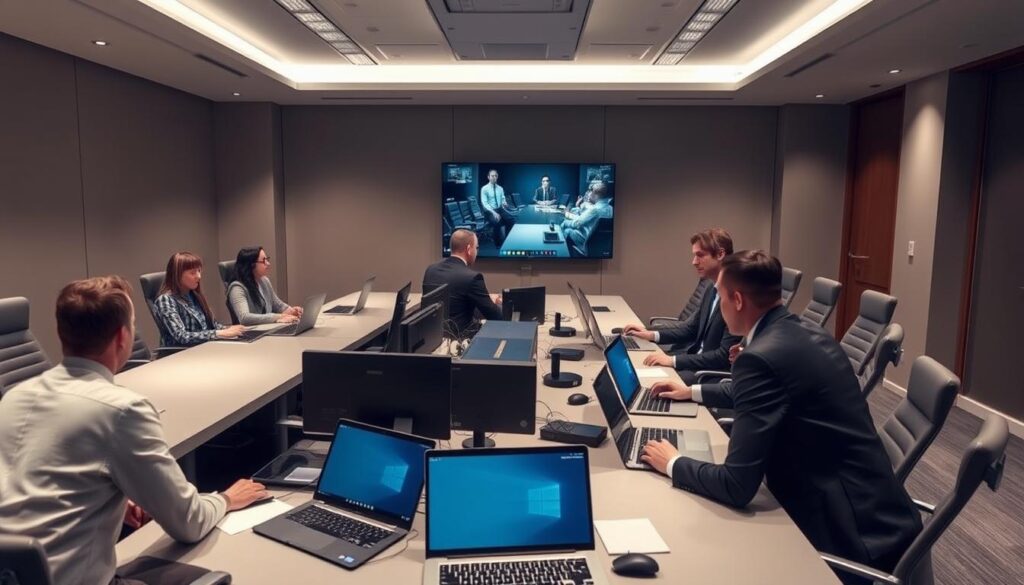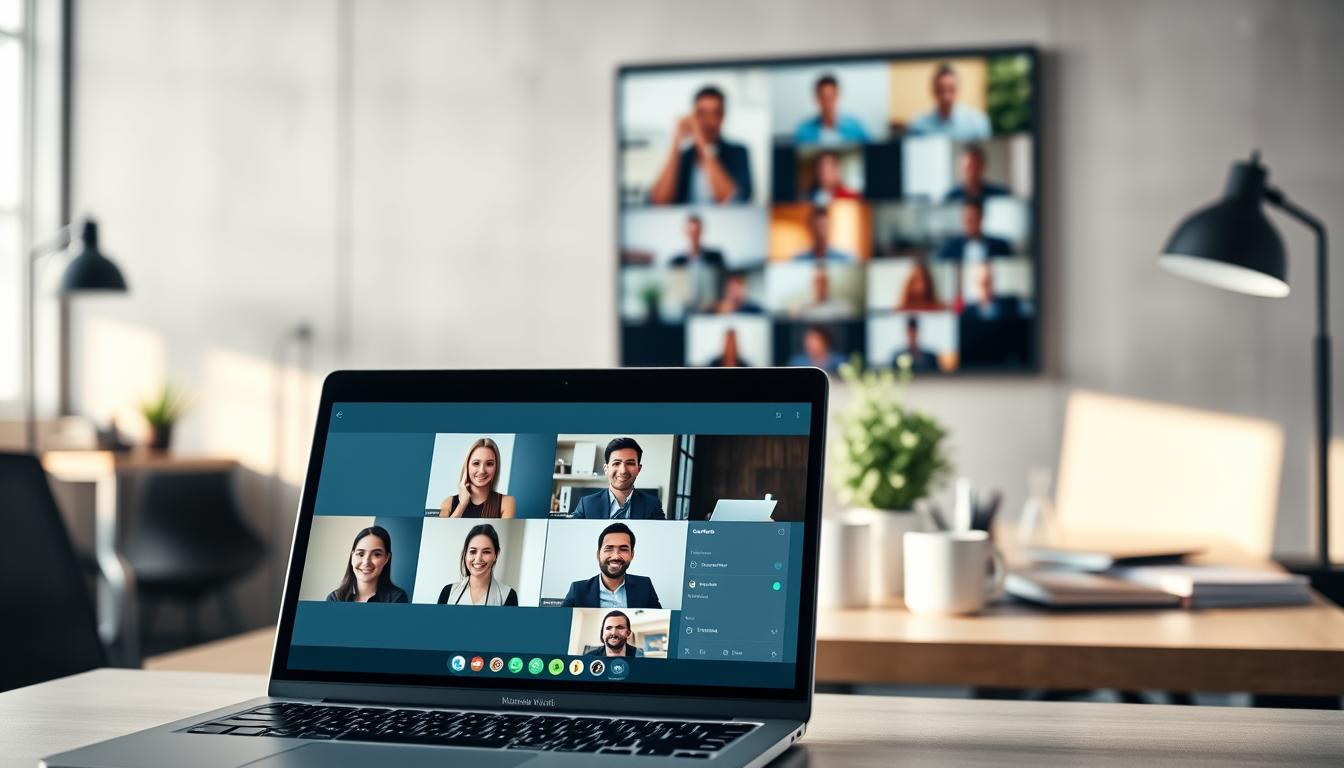The modern workplace faces a big challenge: too many meetings that don’t help and interrupt work. In the U.S., about 11 million meetings happen every day. More than 71% of top managers agree these are often useless, costing $37 billion a year in lost productivity. This article will explore ways to make meetings better and more productive. It will provide tips to change how teams work together and enhance cooperation at work.
The Meeting Problem: Statistics and Insights
Meeting culture has greatly changed, especially lately. With new work styles, lots of organizations deal with ineffective meetings. These can be very costly, eating up lots of time and slowing down the whole team.
Understanding the Cost of Unproductive Meetings
Ineffective meetings are a big drain on time and energy at work. Managers find themselves stuck in meetings for over 13 hours each week. That’s about 20% of their whole workweek gone. This leads to a drop in how well they can focus, down to just 62%. People who need to think for their jobs, like creators, sit in meetings for about 392 hours a year. This takes away from their real work. What’s worse, almost all continuous meetings don’t even have a set end. This makes for endless inefficiency and extra costs from too many meetings.
The Rise of Meetings Post-Pandemic
After the pandemic, the number of meetings went up. Teams are using digital tools more, which leads to more ineffective meetings. This makes losing productivity even easier across different fields. People are trying to manage a mix of online and offline meetings. This causes a chopped-up workday, making it hard to focus on important tasks.
Identifying the Purpose of Meetings
It’s really important to know why we have meetings. This makes sure they actually help us achieve our goals. Without clear purposes, meetings can waste time and make everyone unhappy. Many experts say that meetings often lack clear focus, making them useless. By setting clear goals for meetings, everyone knows why they’re there and what they’re supposed to do.
Defining Clear Objectives for Each Meeting
Having clear goals is key to a meeting’s success. Knowing what you want to achieve makes the meeting worth the time. Meetings could be for solving problems, making choices, or coming up with new ideas. Having clear goals makes everyone more involved and productive. By knowing the goals in advance, people can come ready to contribute to the discussion.
Evaluating the Relevance and Urgency of Meetings
Think about if a meeting is really necessary before setting it up. Sometimes, an email or a quick chat is enough for some topics. By focusing on what truly needs a meeting, we can save time and resources. This way, meetings are only held when they’re really needed. And this helps everyone work better together.
Preparing for Effective Meetings
Meeting success starts way before anyone steps into the room. Getting ready is key to making discussions focused and useful. A top tip is to share meeting agendas early. Yet, many meetings happen without clear agendas, leading to aimless talk.
Creating and Distributing Agendas in Advance
Meeting agendas act like a map, keeping things moving in the right direction. Sharing them a day before cuts meeting times by 13%. This step makes meetings more engaging and lets people prep better. When everyone knows what’s coming, they bring valuable info and thoughts, improving discussions.
Setting Expectations for Participants
Knowing what’s expected is crucial for good meetings. When people know their jobs and goals, meetings are more likely to go well. Sending out expectations with agendas makes everyone’s role clear. This boosts responsibility and lets team members add more to the meeting. Stressing prep work helps build a culture where quick, useful meetings are the norm.
Managing Meeting Time Efficiently
Managing time well during meetings boosts productivity and keeps everyone involved. Starting on time shows respect for each person’s time. It helps focus the conversation. Using timers helps keep meetings structured and disciplined.
Implementing Timers and Alarms to Stay on Track
Using timers in meetings reminds people to stay focused. They help schedule specific times for each topic on the agenda. This stops meetings from running over their planned time, a common problem in organizations.
Prioritizing Key Topics for Discussion
Choosing the most important topics keeps meetings aimed at significant issues. Clear priorities lead to valuable discussions without getting off track. Focusing on key topics makes meetings more effective and respects time limits for each item.
Facilitating Productive Discussions
Effective facilitation helps make discussions during meetings productive. It lets team members feel important and eager to share ideas. Focusing on including everyone in meetings draws out many viewpoints. This leads to a discussion that benefits all.
Encouraging Participation and Inclusivity
Facilitators should use strategies to get everyone involved. Methods like round-robin sharing or breaking into small groups make sure all voices are heard. Inviting quieter members to speak can make the conversation richer and bring up new ideas.
Setting Ground Rules for Discussions
It’s important to have ground rules for discussions to keep meetings respectful and productive. Rules about not interrupting, listening well, and when to speak help meetings run smoothly. This structure makes it easier for facilitators to lead discussions and avoid conflicts.
Optimizing Meetings for Deep Work Time
Effective meeting schedules are crucial for deep work. Studies show interruptions can severely lower productivity. It can take up to 23 minutes to focus again after being disturbed. By planning meetings carefully, workers can reduce interruptions. This helps create a better environment for focused work.
Scheduling Meetings Effectively to Minimize Disruption
To boost work quality, think about when and how often you hold meetings. Here are some tips for better planning:
- Consolidate meetings into designated blocks
- Avoid scheduling during peak focus hours
- Use tools to find optimal times based on team availability
Recognizing the Importance of Focus Time
Companies must value uninterrupted work time for deep concentration. Realizing the importance of focus can lead to:
- A culture that values uninterrupted work
- Improved employee satisfaction and productivity
- Enhanced creativity and problem-solving capabilities
Meeting Culture for Efficiency
A strong meeting culture improves how we talk and make decisions. Learning when to meet and when to email makes teams work better. It’s important to choose between meetings and emails to make work smoother.
Understanding When to Hold Meetings vs. Email
Knowing when to meet or email saves time. Emails work great for quick updates or questions. But, face-to-face talks are better for big issues with many people. Teams need rules to tell when to meet and when an email is enough.
Fostering a Culture that Values Focused Work
A culture that loves focused work helps everyone do their best. Fewer meetings mean more time to work without breaks. This leads to better results. Pushing for good communication makes every meeting or email count.
Post-Meeting Follow-Up Best Practices
Effective follow-up after meetings is key to keeping teams on the same page. Sending out the meeting notes quickly is very important. It helps everyone remember what was decided and what they need to do.
Meeting minutes summarize the important decisions and who is in charge of each task. Sending these notes quickly helps set clear goals for the team.
Distributing Action Items and Minutes Promptly
After a meeting ends, it’s important to send the notes to everyone fast. This includes:
- Summarizing key points discussed
- Listing clear action items with deadlines
- Identifying team members responsible for each action
This way, the team stays organized and focused on their tasks.
Tracking Progress on Assigned Tasks
Keeping track of task progress is crucial. There are several ways to do this:
- Weekly check-ins on assigned action items
- Utilizing project management tools for visibility
- Encouraging open communication about obstacles and achievements
This method keeps everyone informed of their duties and encourages responsibility. Regular updates also measure how effective the meeting was and help the team finish their tasks.
Utilizing Technology for Meeting Optimization
In the modern workplace, using tech during meetings boosts efficiency and productivity. Digital tools help make meetings smoother and improve team collaboration. This tech shift makes planning easier and meetings more engaging.
Leveraging Digital Tools to Improve Meeting Processes
Different tools offer solutions for better time and resource management. With features like live collaboration, shared plans, and video calls, teams can work together easily, no matter where they are. Tools like Zoom, Microsoft Teams, and Slack let companies get the most out of meeting tech. They help keep discussions on track and outcome-focused.
Measuring Meeting Effectiveness with Analytics
It’s important to know how well meetings are doing. With analytics tools from Flowtrace, companies can watch meeting trends, who’s coming, and how engaged they are. This smart approach makes it easier to perfect digital meetings. Teams learn what meeting styles are best and what needs changing. Using data to guide meeting strategies makes every talk meaningful and straight to the point.

Conclusion
Optimizing meeting culture is key for improving work performance. It helps in making meetings productive. By planning meetings well and following up, we cut down on wasted time. This approach makes sure we use our meeting time wisely.
It’s crucial to mix meetings with time to focus on work. Knowing when to meet or email helps everyone work better together. By improving how we meet, teams work better, and everyone is happier at work.
As work changes, making these meeting habits normal will bring long-term gains. Improving meeting culture is a constant journey, but it’s worth it.



